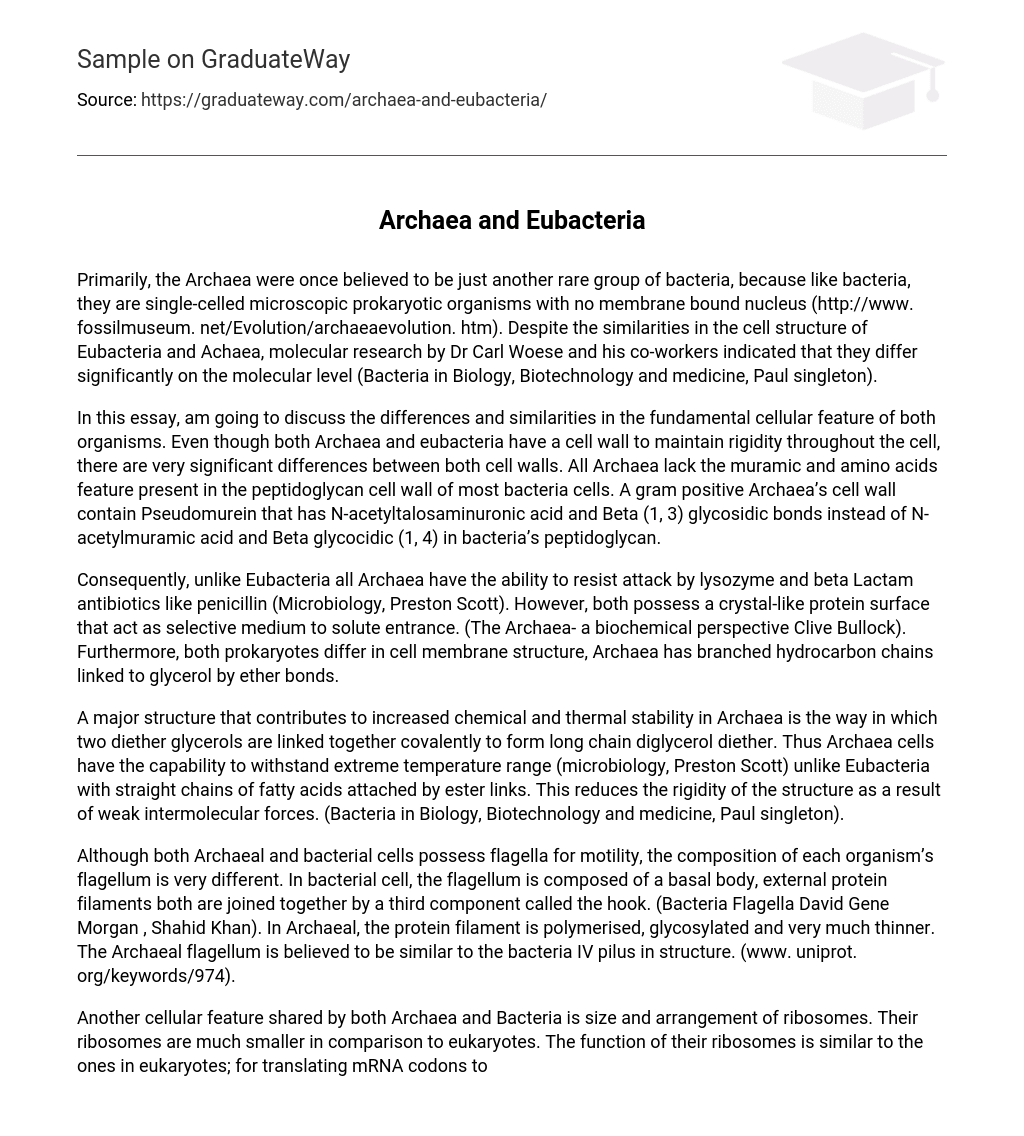Primarily, the Archaea were once believed to be just another rare group of bacteria, because like bacteria, they are single-celled microscopic prokaryotic organisms with no membrane bound nucleus (http://www. fossilmuseum. net/Evolution/archaeaevolution. htm). Despite the similarities in the cell structure of Eubacteria and Achaea, molecular research by Dr Carl Woese and his co-workers indicated that they differ significantly on the molecular level (Bacteria in Biology, Biotechnology and medicine, Paul singleton).
In this essay, am going to discuss the differences and similarities in the fundamental cellular feature of both organisms. Even though both Archaea and eubacteria have a cell wall to maintain rigidity throughout the cell, there are very significant differences between both cell walls. All Archaea lack the muramic and amino acids feature present in the peptidoglycan cell wall of most bacteria cells. A gram positive Archaea’s cell wall contain Pseudomurein that has N-acetyltalosaminuronic acid and Beta (1, 3) glycosidic bonds instead of N-acetylmuramic acid and Beta glycocidic (1, 4) in bacteria’s peptidoglycan.
Consequently, unlike Eubacteria all Archaea have the ability to resist attack by lysozyme and beta Lactam antibiotics like penicillin (Microbiology, Preston Scott). However, both possess a crystal-like protein surface that act as selective medium to solute entrance. (The Archaea- a biochemical perspective Clive Bullock). Furthermore, both prokaryotes differ in cell membrane structure, Archaea has branched hydrocarbon chains linked to glycerol by ether bonds.
A major structure that contributes to increased chemical and thermal stability in Archaea is the way in which two diether glycerols are linked together covalently to form long chain diglycerol diether. Thus Archaea cells have the capability to withstand extreme temperature range (microbiology, Preston Scott) unlike Eubacteria with straight chains of fatty acids attached by ester links. This reduces the rigidity of the structure as a result of weak intermolecular forces. (Bacteria in Biology, Biotechnology and medicine, Paul singleton).
Although both Archaeal and bacterial cells possess flagella for motility, the composition of each organism’s flagellum is very different. In bacterial cell, the flagellum is composed of a basal body, external protein filaments both are joined together by a third component called the hook. (Bacteria Flagella David Gene Morgan , Shahid Khan). In Archaeal, the protein filament is polymerised, glycosylated and very much thinner. The Archaeal flagellum is believed to be similar to the bacteria IV pilus in structure. (www. uniprot. org/keywords/974).
Another cellular feature shared by both Archaea and Bacteria is size and arrangement of ribosomes. Their ribosomes are much smaller in comparison to eukaryotes. The function of their ribosomes is similar to the ones in eukaryotes; for translating mRNA codons to sequence of amino acids for the synthesis of proteins. Both have 70S Ribosomes composed of 30S and 50S sub units that are joined to make a 70S unit. They contain “three ribonucleic acid molecules” consisting of “16S, 23S AND 5S”. On the other hand, the “primary structure of Archaea r-RNA and r-Proteins” is much similar to the ones in eukaryotes and less similar to that of bacteria.
Additionally, the Archaea ribosome is much firm compared to mesophilic bacteria’s ribosomes, this is particularly beneficial in terms of their adaptation to extreme environmental conditions. (Archaeal Ribosomes, Paola Londei, university of Rome, “Sapienza” Italy December 2010). As a result of the lack of cell nucleus in Archaea and Eubacteria they do not reproduce by mitosis reproduce asexually through the process of binary fission where the DNA and chromosomes replicate and the two strands are then pulled apart as the cell grows. Multiple fission” is possible as more than two daughter cells can be created and pulled apart. A bacterium has the ability to produces endospores which allow them to remain dormant for over the years unlike the Archaea. (http://www. eoearth. org/article/Archaea? topic=49496 Archaea C Michael Hogan) Despite the fact that both domains have single circular DNA, the “DNA dependent RNA polymerase” in both is very different. The RNA polymerase is in charge of generating mRNA that is later transformed into proteins at the ribosomes.
In bacteria, RNA polymerase contains 5 different proteins and much simpler in comparison with Archaea’s consisting of 8 different proteins among methanogenic and halophilic archaea and 10 different more complex proteins in thermophilic archaea. In addition, all the Archaea RNA polymerase is resistant to inhibition by antibiotic “rifampicin” whereas bacterial RNA polymerase isn’t. (http://www. microbiologytext. com/index. php? module=Book&func=displayarticle&art_id=73) In conclusion, although there are several





